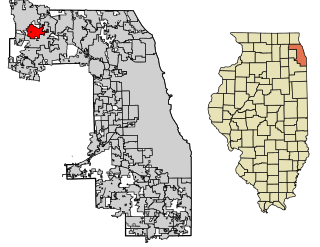
South Barrington is a residential suburb in Cook County, Illinois, United States, south of Barrington. Per the 2020 census, the population was 5,077. South Barrington is a wealthy suburb of Chicago. It is the location of the famous megachurch Willow Creek Community Church, Goebbert's Pumpkin Patch and Farm, and a lifestyle center named The Arboretum of South Barrington.

Lincoln Park is a designated community area on the North Side of Chicago, Illinois. It is located west of Lincoln Park.
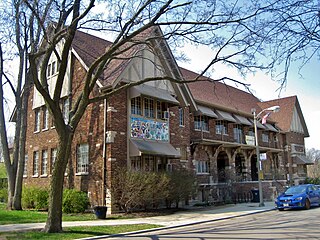
Albany Park is one of 77 well-defined community areas of Chicago. Located on the Northwest Side of the City of Chicago with the North Branch of the Chicago River forming its east and north boundaries, it includes the ethnically diverse Albany Park neighborhood, with one of the highest percentages of foreign-born residents of any Chicago neighborhood.

Austin is one of 77 community areas in Chicago. Located on the city's West Side, it is the third largest community area by population and the second-largest geographically. Austin's eastern boundary is the Belt Railway located just east of Cicero Avenue. Its northernmost border is the Milwaukee District / West Line. Its southernmost border is at Roosevelt Road from the Belt Railway west to Austin Boulevard. The northernmost portion, north of North Avenue, extends west to Harlem Avenue, abutting Elmwood Park. In addition to Elmwood Park, Austin also borders the suburbs of Cicero and Oak Park.

Hermosa is one of 77 designated Chicago community areas and is located on the northwest side of Chicago, Illinois. The Hermosa community area contains the Kelvyn Park and Hermosa neighborhoods. The area includes the birthplace of Walt Disney and is the former headquarters of the Schwinn Bicycle Company. While being one of the smaller community areas, Hermosa is one of the city's most densely populated neighborhoods.
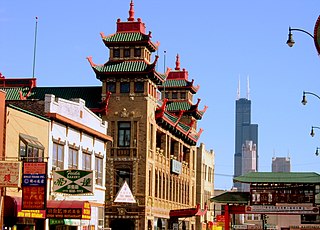
Armour Square is a Chicago neighborhood on the city's South Side, as well as a larger, officially defined community area, which also includes Chinatown and the CHA Wentworth Gardens housing project. Armour Square is bordered by Bridgeport to the west, Pilsen to the northwest, Douglas and Grand Boulevard to the east and southeast, and with the Near South Side bordering the area to the north, and Fuller Park bordering its southernmost boundary, along Pershing Road.
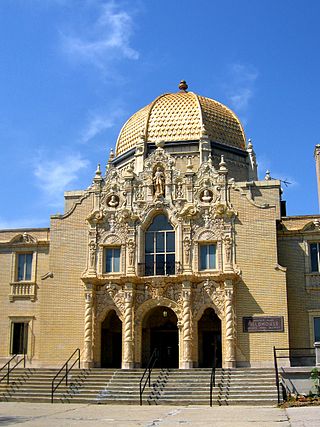
East Garfield Park is a neighborhood on the West Side of Chicago, Illinois, west of the Loop.

Lower West Side is a community area on the West Side of Chicago, Illinois, United States. It is three miles southwest of the Chicago Loop and its main neighborhood is Pilsen. The Heart of Chicago is a neighborhood in the southwest corner of the Lower West Side.

Chatham is one of the 77 community areas of Chicago, Illinois, on the city's South Side. It includes the neighborhoods of Chatham-Avalon, Chatham Club, Chesterfield, East Chatham, West Chatham and the northern portion of West Chesterfield. Its residents are predominantly African American, and it is home to former Senator Roland Burris. Housing many city employees and other officials, Chatham has been a central area for Chicago's middle-class African Americans since the late 1950s.

Calumet Heights, located on the South Side of the city, is one of the 77 well defined community areas of Chicago, Illinois. Calumet Heights is bounded by 87th Street on the north, South Chicago Avenue on the east, and railroad lines on the west and south.

Chicago Lawn is one of the 77 community areas of Chicago, Illinois. It is located on the southwest side of the city. Its community neighbors include Gage Park, West Englewood, Ashburn, and West Lawn. It is bounded by Bell Avenue on the east, Central Park Avenue on the west, 59th Street on the north, and 75th Street on the south, and is 13 km (8.1 mi) southwest of the Loop. Local citizens refer to the area as "Marquette Park," after the park in its center.

Olney is a neighborhood in the North Philadelphia section of Philadelphia. It is roughly bounded by Roosevelt Boulevard to the south, Tacony Creek to the east, Godfrey Avenue to the north, and the railroad right-of-way west of 7th Street to the west.
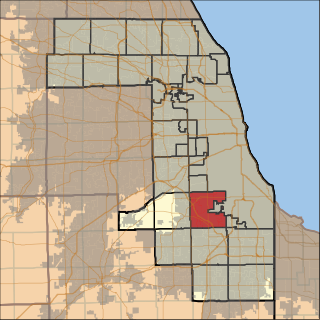
Worth Township is one of 29 townships in Cook County, Illinois. As of the 2020 census, its population was 152,934, with its most populous municipalities including Oak Lawn, Evergreen Park (19,943), Alsip, and Chicago Ridge. It was founded in 1849, when the county voted to subdivide itself into townships.
East Tampa is a district within the city limits of Tampa, Florida. As of the 2010 census the neighborhood had a population of 16,355. The ZIP Codes serving the neighborhood are 33605 and 33610. The district is about four miles northeast of Downtown Tampa.

Palos Township is one of 29 townships in Cook County, Illinois. As of the 2020 census, its population was 56,836, with its most populous municipality being Palos Hills. The vast majority of the township's population resides in its eastern half; the half west of La Grange Road consists of the Palos Forest Preserves, a section of the Cook County Forest Preserves. In 1850 the small town of Trenton, Illinois changed its name to Palos; this recommendation was made by M.S. Powell, the local postmaster, whose ancestor supposedly sailed with Christopher Columbus from Palos de la Frontera. When it incorporated as a village in 1914, Palos officially became Palos Park. Nearby communities incorporated later: Hickory Hills, in 1951, and Palos Hills, in 1958. All three municipalities lie completely or substantially within Palos Township. Palos Heights, partially in Worth Township, incorporated in 1959.
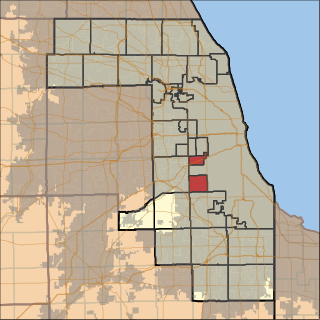
Stickney Township is one of 29 townships in Cook County, Illinois. As of the 2020 census, its population was 41,514, with approximately 71% of that total living in the city of Burbank.
Parkview is a residential neighbourhood in west Edmonton, Alberta, Canada. Parkview is one of the larger residential neighbourhoods in the city, and is located adjacent to the North Saskatchewan River Valley in the west portion of the City. The neighbourhood has good access to Whitemud Drive and Stony Plain Road, and the interior street layout is based on a modified grid network.
Gandy/Sun Bay South is a neighborhood within the city limits of Tampa, Florida. As of the 2010 census, the neighborhood had a population of 14,912. The ZIP Codes serving the area are 33611 and 33616.

Price Hill is a region of Cincinnati, Ohio consisting of three neighborhoods: East Price Hill, West Price Hill, and Lower Price Hill. The region is located in the western part of the city, neighbored by Sedamsville and Riverside to the south, Westwood and South Fairmount to the north, and Queensgate to the west. Originally one of the oldest suburbs of Cincinnati, the region is predominately Catholic, having been an ethnic enclave for both Irish and German Catholics. Price Hill's neighborhoods are residential communities, having a combined population of 36,271 at the 2020 census.
Wrightwood is a neighborhood on the far southwest side of Chicago, Illinois. Wrightwood is located within the Greater Ashburn community area, in its eastern section. The neighborhood is bounded by Columbus Avenue (north), Western Avenue (east), 87th Street (south), and Kedzie Avenue (west). The neighborhood is predominantly African-American and middle-class. It was the first section of Ashburn to racially integrate.

















